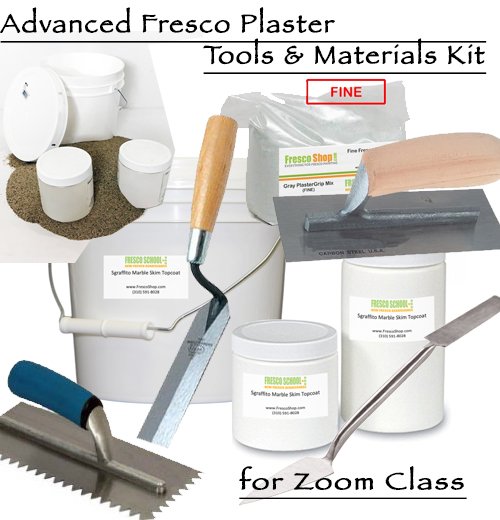
Build up your fresco plastering skills at the minimum cost!
To gain experience in plastering at a minimal cost it is possible to prepare a “Practice Lime Putty” from common Type-S Hydrated Construction Lime.
Type-S Hydrated Lime is manufactured from Dolomitic Limestone (Dolomitic limestone contains 35 to 46 percent magnesium carbonate).
Being a great lime to practice fresco plaster application techniques, this lime is NOT suitable for the actual painting in fresco due to high content of magnesium which leads to fast setting, poor adhesion/binding of colors and efforescence on the color layer. However, it is widely used in construction (for which it was developed and manufactured: Type-S stands for “Special”) and is available at very low cost almost at any building supplies retailer.
1 – How To Prepare Lime Putty from powdered Type-S Hydrated Constriction Lime?
2 – Fresco Plaster Mixing Proportions.
General fresco plaster mixing proportions are 1 part lime putty to 2 parts aggregate (river sand) for the base layers and 5 parts lime putty to 8 parts aggregate. Aggregate is the “inert filler” most often river sand. River sand is a “young sand” angular, not tumbled as the sea sand would be also it is clean from salts. You can find it at any masonry supply place or HomeDepot like stores, labeled as “Washed Plaster Sand”. You will need to sift it through 1/16 mesh – regular fly window screen will work just fine 🙂
You can find detailed, real time tutorial on fresco plastering here: http://frescovideos.com/fresco-plaster-buon-fresco-painting-foundations-vol-1
Please stay away from 1 part lime to 1 part aggregate plaster mixes (you might find referenced on the internet and some books), those may appear easier to apply but are very difficult to paint on with low color absorption due to high density. Those are Roman-style plasters which were abandoned by Renaissance painters due to limited “paintability”. Also beginners have a tendency to start painting too early, not giving plaster enough time to set as well as apply too thick which will result in cracking.
3 – What is Lime Putty?
Lime Putty is the main ingredient of the buon fresco painting. Only high calcium lime putty should be used for fresco painting. The first step (which in nowadays mainly done by the factories) is the heating (calcination) of marble or limestone (calcium carbonate, CaCO3) at 800-900ßC to make porous lime (calcium oxide, CaO).
HEAT + CaCO3(s) —-> CaO(s) + CO2(g)
To form lime putty, the lime is “slaked.” The slaking process, which requires the addition of 2 or 3 molecules of water for each molecule of lime, yields calcium paste or lime putty, an aqueous gel of thin crystals of calcium hydroxide.
CaO(s) + H2O(l) —-> Ca(OH)2(s) + HEAT
Excess water acts as a lubricant so that the molecules slide easily over one another. Historically, lime was slaked in pits or troughs over a period of at least six months to obtain lime putty of the desired consistency. Artisans in Michelangelo’s time used plaster aged for as long as ten years.



